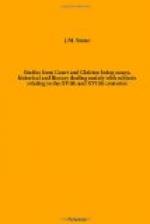The Royal Ms. 2 B 3, commonly known as Queen Mary’s Psalter, is a good specimen of fourteenth century art. This is a large octavo volume of 320 leaves of vellum, almost everyone being magnificently illuminated on both sides, with daintily executed drawings, lightly sketched, and slightly tinted in green, brown, and violet. One richly-decorated page represents the Last Judgement. At the top, a miniature within the border shows forth the judge of all mankind. Angels with green-tipped wings hover on either side. Before the Saviour as judge kneel the Blessed Virgin and St. John, and on the other side is a group of monks. The background is of pure gold. Underneath, enclosed in a blue and white border, the dead rise to judgment. Angels blow long trumpets and the graves open. Below this again is a lovely initial, with more figures on a gold background. The letter begins the words of the Litany Kyrie eleison. A drawing at the bottom of the page represents Saul receiving the letter to Damascus for the persecution of the Christians. This page, as elaborate and glowing with colour as it is rich in design and fine in execution, is, however, not more striking than many others in the same manuscript, which may, without too much praise, be described as a gem of palaeographic art. A note on the last leaf explains that the Ms. was on the point of being carried beyond seas, when a customs officer, one Baldwin Smith, in the port of London seized and presented it to the Queen, in October 1553, the first year of her reign.
The writer does not record whether the hapless owner was indemnified for his loss. It was probably Queen Mary herself who caused the book to be bound as we now see it, in the worn crimson velvet binding, with the remains of large pomegranates embroidered at each corner, pomegranates being her own badge.
The Ms. 2 B 7 is an extremely beautiful piece of workmanship of the fourteenth century. Its delicate outline drawings, mostly in mauve and green, are reminiscent of the Guthlac roll. They represent mainly an illustrated Martyrology of Saints, popular in England. 1 A 18 is the copy of the Latin Gospels presented to Christ Church, Canterbury, by King Athelstan, with the name Lumley on the first page of the Eusebian canons, and Umfridus me fecit on a fly-leaf.
The beautiful French version of the Apocalypse, written in England about 1330 (19 B R5), contains drawings of great refinement, though scarcely to be compared with those which adorn Queen Mary’s Psalter.
The very large Bible of the end of the fourteenth century measuring twenty-four by Leventeen inches, is splendidly illuminated and profusely adorned with miniatures.
But choice and variety are infinite, and to the devout lover of these things, the Royal library resembles a goldmine with nuggets of immense value lying in profusion wherever his adventurous footsteps lead him. If his object be delight he will find that every step leads him there.




